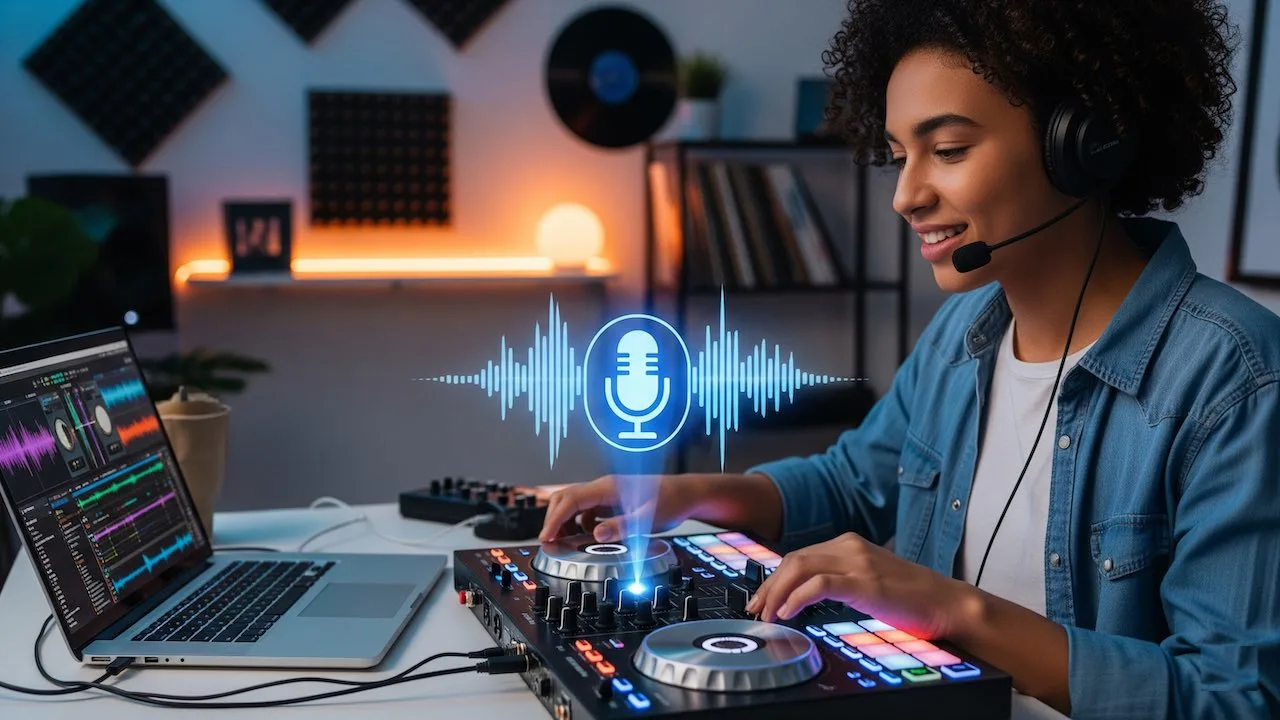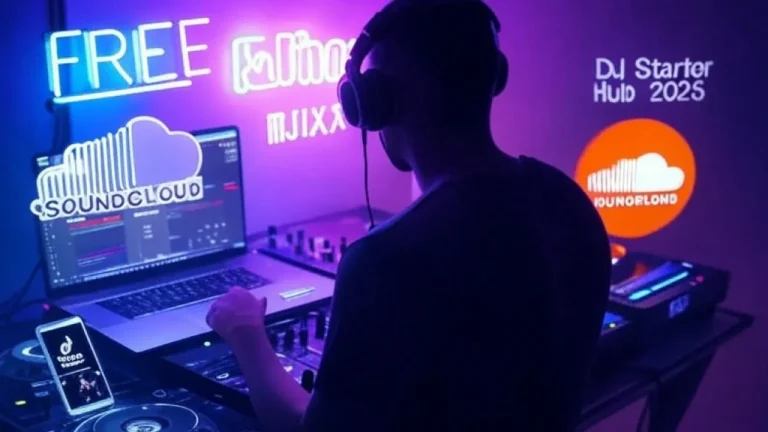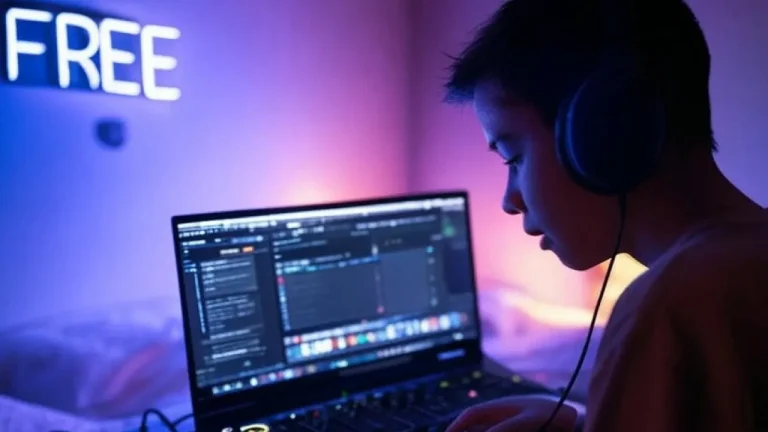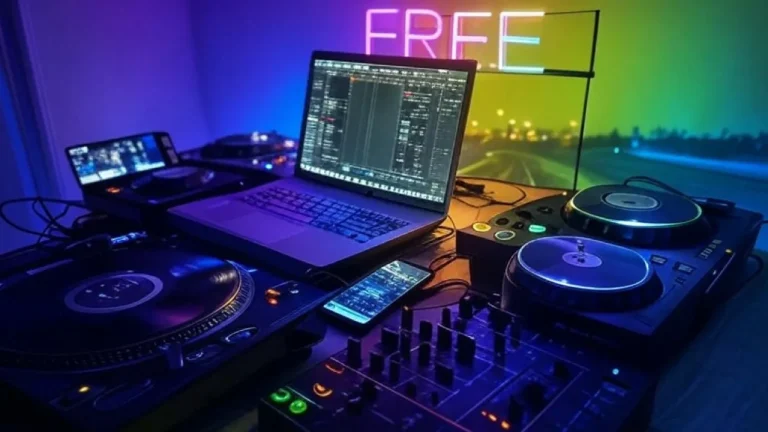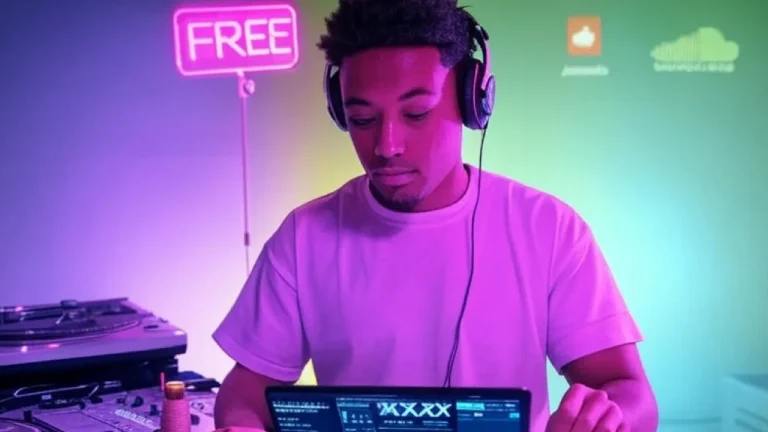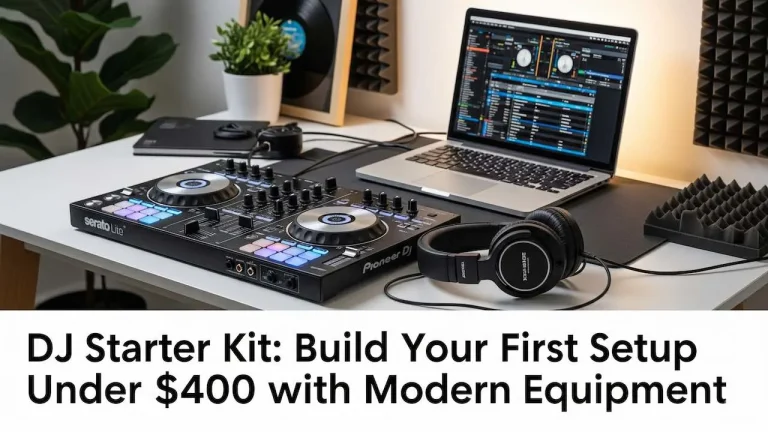Voice-controlled DJing lets beginners mix music hands-free using AI commands and smart DJ software. Modern DJ apps like Algoriddim’s djay Pro and Spotify’s AI DJ now support voice commands, making mixing accessible for newcomers who want to focus on creativity rather than complex button combinations.
What Is Voice-Controlled DJing and How Does It Work?
Voice-controlled DJing uses AI technology to interpret spoken commands and execute DJ functions automatically. You can say “Hey DJ, play something upbeat” and the software responds by selecting high-energy tracks that match your request. This hands-free approach removes technical barriers that often intimidate new DJs.
The technology works through natural language processing that understands music-related commands. Popular voice-enabled DJ platforms include:
- Algoriddim djay Pro with Apple Music integration
- Spotify AI DJ with voice command features
- Virtual DJ with AI-powered auto-mixing
- DJ.Studio’s AI mixing capabilities
Essential Equipment for Voice-Controlled DJ Setups
Voice-controlled DJing requires minimal hardware compared to traditional setups. A basic controller, computer, and microphone create the foundation for hands-free mixing. Entry-level options cost significantly less than professional gear while delivering professional results.
| Equipment | Recommended Models | Price Range |
|---|---|---|
| DJ Controller | Numark DJ2GO2 Touch, Hercules DJ Control Starlight | $50-$150 |
| Software | Serato DJ Lite, djay Pro, Virtual DJ | Free-$19/month |
| Microphone | Blue Yeti, Audio-Technica ATR2100x-USB | $70-$200 |
| Speakers | Turbosound iQ10, Pioneer DJ DM-40 | $100-$300 |
Budget-Friendly Controller Options
The Numark DJ2GO2 Touch serves as an excellent starting point for voice-controlled mixing. This compact 2-channel controller connects seamlessly with voice-enabled software while maintaining portability for mobile DJing. Its touch-sensitive jog wheels respond to both manual and voice commands.
Hercules DJ Control Starlight offers another beginner-friendly option with built-in light shows. The controller integrates with djay Pro’s voice features, allowing you to trigger effects through spoken commands while visual elements respond automatically.
Top Voice-Enabled DJ Software Platforms
Modern DJ software incorporates AI assistants that understand natural speech patterns. These platforms analyze your voice commands and translate them into precise mixing actions, making complex techniques accessible to beginners without extensive training.
Algoriddim djay Pro
djay Pro leads voice-controlled DJing with Apple Music integration and AI mixing features. The software recognizes over 50 voice commands including tempo requests, genre changes, and effect triggers. Users can access 100 million songs through voice search, eliminating manual browsing during performances.
Key voice features include:
- Natural language song requests
- Automatic BPM matching through voice commands
- Hands-free loop creation and effects
- Voice-activated crossfader control
Spotify AI DJ Integration
Spotify’s AI DJ feature now supports voice commands for personalized music curation. The system learns your preferences and responds to mood-based requests like “play something upbeat for dancing”. This integration works particularly well for house parties and casual events.
| Voice Command | DJ Software Response | Use Case |
|---|---|---|
| “Play something upbeat” | Selects high-energy tracks 120+ BPM | Dance floor activation |
| “Slow it down” | Transitions to slower tempo songs | Cool-down periods |
| “Add some bass” | Applies low-frequency EQ boost | Energy enhancement |
| “Crossfade left” | Moves crossfader to left deck | Track transitions |
Setting Up Your First Voice-Controlled DJ Session
Creating your first voice-controlled mix requires proper software configuration and microphone setup. Most voice-enabled DJ software includes setup wizards that calibrate voice recognition for your specific environment. Background noise calibration prevents accidental command triggers during performances.
Software Configuration Steps
Start by downloading your chosen DJ software and connecting your controller. Enable voice recognition in the settings menu and complete the voice training process by repeating common commands. This training improves accuracy and reduces misinterpreted commands during live mixing.
Configure your microphone input levels to avoid feedback while maintaining clear command recognition. Most platforms recommend speaking 6-12 inches from the microphone for optimal voice detection.
Basic Voice Commands for Beginners
Learning essential voice commands accelerates your DJing progress significantly. Start with simple requests like tempo changes and song selection before progressing to advanced effects. Practice these commands during quiet sessions to build muscle memory.
Essential beginner commands include:
- “Play next track” – Advances to the next song in queue
- “Increase tempo” – Gradually raises BPM for energy builds
- “Add reverb” – Applies atmospheric effects to current track
- “Mix in bass” – Enhances low-frequency content
- “Fade out” – Gradually reduces volume for smooth endings
Advanced Voice Control Techniques
Experienced voice-controlled DJs combine multiple commands for complex mixing sequences. Advanced users create custom voice macros that execute multiple actions simultaneously, such as triggering effects while adjusting EQ settings through single commands.
Creating Voice Command Sequences
Modern DJ software allows custom command creation for personalized workflows. You can program phrases like “drop the beat” to simultaneously cut bass frequencies, add filter sweeps, and trigger dramatic volume cuts. These sequences create professional-sounding drops without manual intervention.
Popular sequence combinations include:
- Build-up commands: “Build energy” triggers gradual tempo increases with rising filters
- Breakdown phrases: “Break it down” reduces elements while maintaining rhythm
- Genre transitions: “Switch to house” changes musical style with appropriate effects
Troubleshooting Common Voice Control Issues
Voice recognition accuracy depends on environmental factors and proper setup. Background noise, poor microphone positioning, and unclear speech patterns cause the most common recognition failures. Regular recalibration maintains optimal performance levels.
Improving Recognition Accuracy
Speak clearly and maintain consistent distance from your microphone during performances. Avoid shouting commands, as this distorts voice patterns and reduces recognition accuracy. Instead, project your voice naturally while maintaining normal speaking volume.
Environmental optimization tips:
- Position microphones away from speakers to prevent feedback
- Use directional microphones in noisy environments
- Recalibrate voice recognition weekly for consistent performance
- Create quiet command zones during loud performances
People Also Ask
Yes, directional microphones and noise-canceling technology allow voice control during loud events. Position your microphone close to your mouth and away from speakers. Many DJs use headset microphones for consistent voice recognition in noisy environments.
All voice-controlled DJ software includes manual override capabilities through traditional controller buttons. Keep your controller within reach as a backup method. Most platforms also offer gesture controls as secondary voice alternatives.
Local voice recognition works offline, but streaming music services require internet connectivity. Download playlists beforehand for offline performances. Cloud-based AI features need internet access for optimal functionality.
Modern DJ voice recognition achieves 85-95% accuracy rates with proper calibration and clear speech. Accuracy improves over time as the software learns your voice patterns. Regular training sessions enhance recognition performance significantly.
Most platforms support multiple voice profiles for shared setups. Each DJ creates individual voice profiles with personalized commands. Switch between profiles before performances to maintain recognition accuracy for different users.
Start with simple, single-action commands like “play,” “stop,” “next track,” and “add bass”. Avoid complex multi-word phrases initially. Build vocabulary gradually as voice recognition improves with practice and system familiarity.
